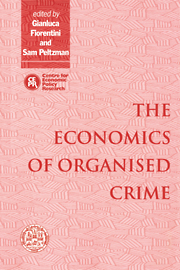Book contents
- Frontmatter
- Contents
- List of figures
- List of tables
- Foreword
- Acknowledgements
- List of conference participants
- 1 Introduction
- PART I THEORIES OF THE STATE AND THE ORIGIN OF CRIMINAL ORGANISATIONS
- PART II THE CRIMINAL ORGANISATION AS A FIRM
- PART III ORGANISED CRIME AND STATE INTERVENTION IN THE ECONOMY
- PART IV DETERRENCE POLICIES AGAINST LEGAL FIRMS INVOLVED IN ILLEGAL ACTIVITIES
- 8 Auditing with ‘ghosts’
- Discussion
- 9 The reputational penalty firms bear from committing criminal fraud
- Discussion
- PART V DETERRENCE POLICIES AGAINST ORGANISED CRIME
- Index
Discussion
Published online by Cambridge University Press: 04 August 2010
- Frontmatter
- Contents
- List of figures
- List of tables
- Foreword
- Acknowledgements
- List of conference participants
- 1 Introduction
- PART I THEORIES OF THE STATE AND THE ORIGIN OF CRIMINAL ORGANISATIONS
- PART II THE CRIMINAL ORGANISATION AS A FIRM
- PART III ORGANISED CRIME AND STATE INTERVENTION IN THE ECONOMY
- PART IV DETERRENCE POLICIES AGAINST LEGAL FIRMS INVOLVED IN ILLEGAL ACTIVITIES
- 8 Auditing with ‘ghosts’
- Discussion
- 9 The reputational penalty firms bear from committing criminal fraud
- Discussion
- PART V DETERRENCE POLICIES AGAINST ORGANISED CRIME
- Index
Summary
Karpoff and Lott's paper considers the incentives firms face to abstain from opportunistic behaviour, comparing the effectiveness of the legal fines with that of the market mechanism and analysing the trade-off between the two instruments. The authors develop initially at a qualitative level a theoretical model, but the focus of the paper is on the empirical evidence they present on the issue.
The market mechanism works through the usual repeated purchase story: a stakeholder – an employee, a customer, a supplier, an investor – who is hurt by the firm's behaviour refuses to conduct economic transactions with the firm in the future. Hence, when committing a fraud, the firm has to compare the short-run benefit with the long-run losses due to a reduction in the economic activity. Then, a firm may invest in reputation – abstaining from these short-run gains – to preserve its longrun profits. The authors claim that legal fines act as imperfect substitutes for the investment in reputation, and that the optimal level of criminal penalties should be evaluated by considering how the investments in reputation are adjusted to a marginal increase in the penalties.
Applying this framework of analysis, the authors criticise the conventional wisdom that penalties for corporate frauds are too low. First, they claim that in most cases the external effects of a fraud are negligible, and the market mechanism is therefore sufficient to discipline the firms. Secondly, since fines and reputation are imperfect substitutes, an increase in penalties increases the total social cost of fraud control.
The article presents a very detailed empirical analysis of this issue considering 132 fraud events referred to different types of frauds.
- Type
- Chapter
- Information
- The Economics of Organised Crime , pp. 246 - 250Publisher: Cambridge University PressPrint publication year: 1996



